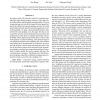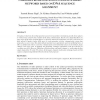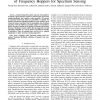134 search results - page 21 / 27 » Two-stage spectrum sensing for cognitive radios |
ICASSP
2011
IEEE
12 years 11 months ago
2011
IEEE
In cognitive radio (CR) networks, multi-CR cooperation typically takes place during spectrum sensing, to cope with wireless fading effects and the hidden terminal problem. The use...
JSAC
2011
13 years 2 months ago
2011
—Opportunistic spectrum access creates the opening of under-utilized portions of the licensed spectrum for reuse, provided that the transmissions of secondary radios do not cause...
CORR
2010
Springer
13 years 6 months ago
2010
Springer
Nowadays, It has been shown that spectrum scarcity increased due to tremendous growth of new players in wireless base system by the evolution of the radio communication. Resent su...
GLOBECOM
2009
IEEE
13 years 11 months ago
2009
IEEE
Characterizing the number and type of transmitters occupying a given frequency band is a critical aspect of spectrum sensing specifically and cognitive radio generally. We present ...
ICASSP
2011
IEEE
12 years 11 months ago
2011
IEEE
In Cognitive Radio (CR) systems, spectrum sensing plays a key role to determine the free frequency bands. However, when the primaryuser (PU) signal spectrum exhibits localized fad...



